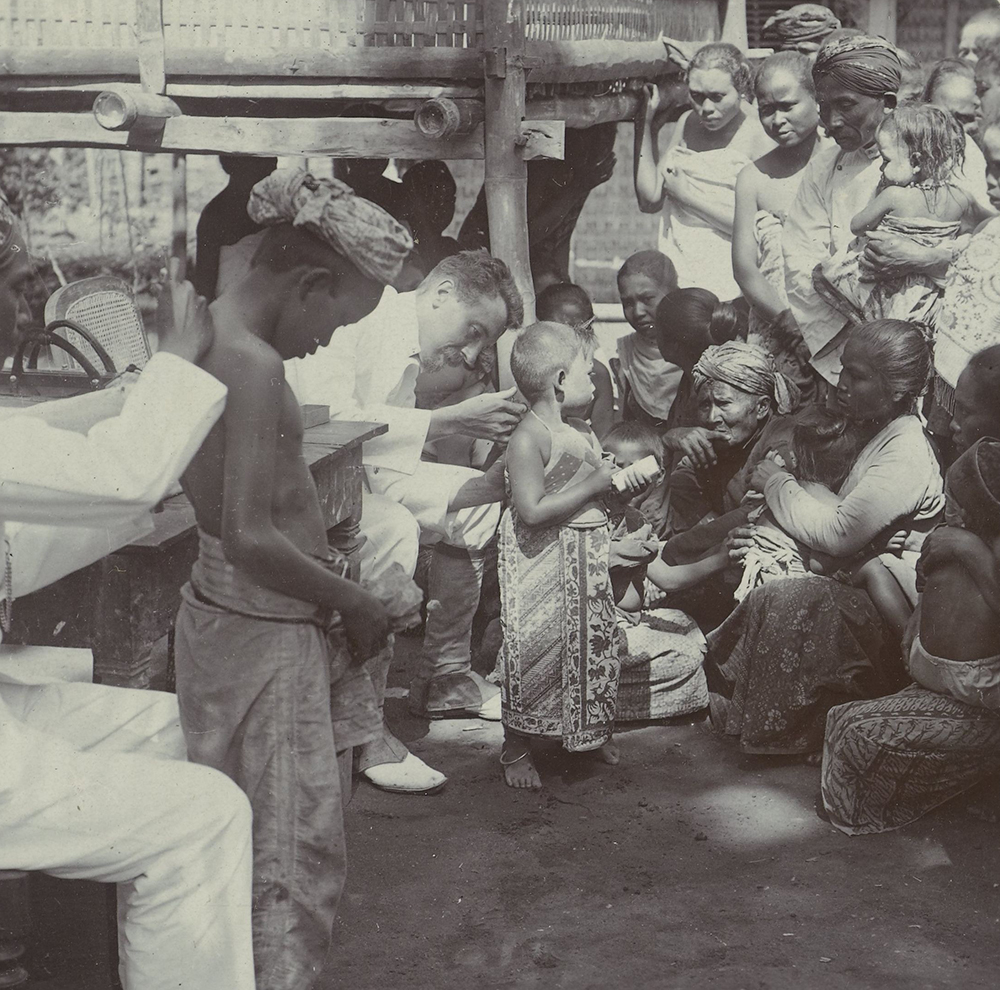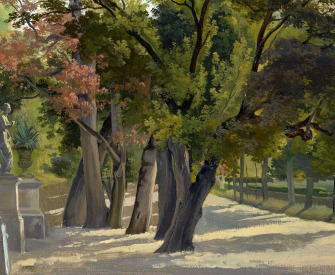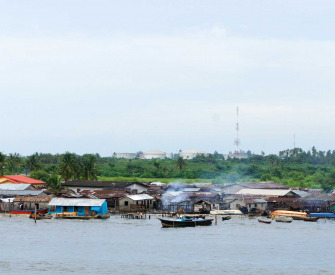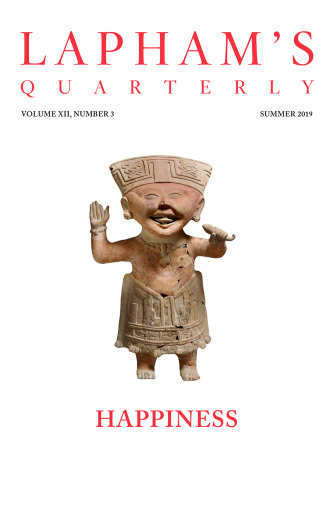How sickness enlarges the dimension of a man’s self to himself! He is his own exclusive object.
—Charles Lamb, 1833Isolation Wards
Taking a tour of the lazarettos.
The first lazaretto I visited was at Marseille. The health office is in the city at the end of the port. It has an outer room and two council chambers. In the outer room, the depositions of captains of ships are taken, who come in their boats to an iron grate. At two feet of distance, there is an iron lattice with a door, which is opened only by the servants of the intendants, or directors, who are here in waiting, in a blue livery trimmed with white lace. Here also letters, or orders for supplies, from the captains who are performing quarantine in their ships, are received with a pair of iron tongs and dipped in a bucket of vinegar standing ready for that purpose.
In the first of the two council chambers, there were hung up a plan of the lazaretto and the picture of a person dying of the plague; also the names of the directors and the weeks of their attendance. Two or more of them are present every day to take the depositions of the captains as they arrive, to fix the guards and porters, and for the other business of this extensive lazaretto.
The lazaretto is on an elevated rock near the city, at the end of the bay, fronting the southwest, and commands the entrance of the harbor. It is very spacious, and its fixation renders it very commodious for the great trade which the French carry on in the Levant. Among other apartments for passengers, there are twenty-four large rooms, of which some are above stairs, and open into a spacious gallery enclosed by lattice. In these rooms are closets for beds, which the passengers and guards are required to bring with them. The guards are sent by the health office, and their number is regulated by the number of passengers of each ship who perform quarantine. A number of passengers not exceeding three are allowed one guard, the expense of whom they are obliged to bear. A passenger, therefore, who has no companion has no assistance in bearing this expense. To four, five, or six passengers two guards are assigned; and to seven, three guards. These guards perform the offices of servants, and will cook for passengers if they do not choose to have their victuals from the tavern.
Within the lazaretto is the governor’s house, and a chapel, in which divine service is regularly performed, as also a tavern, from which persons under quarantine may have their dinners and slippers sent them, and which has likewise the exclusive privilege of supplying them with wine. Two days before the quarantine is finished, the bills are sent in, which being paid to the cashier, they receive a clean patent.
The quarantine of passengers who come with a foul bill, or in one of the first two ships from the same place with a clean bill, is thirty-one days, including the day they go out. If any account arrives of the plague having broken out in the place from which they came with a clean bill, after they left it, they are allowed no advantage from their clean bill; for in this case, they must be confined fifteen days, and also fumigated before they come downstairs and are permitted to go to the parlors. In case any of the company to which they belong die, their quarantine recommences.
The parlors are long galleries with seats in them, situated between the gates and separated by wooden balustrades and wire lattice, beyond which there are other balustrades, distant about ten feet, at which the persons in quarantine may see and converse with such friends as may choose to visit them. The wires are intended to prevent anything from being handed to them or from them. And that nothing may be thrown over, and no escapes be made, there is a double wall around the lazaretto.
At Livorno there are three lazarettos. One of them is new. I was there in 1778 and saw forty-seven slaves employed in building it. Ships which have the plague on board are now received here and not chased away or burned, as is practiced in too many places. The greatest attention is given both to the health and convenience of the passengers, and the merchandise is kept in the exactest order. This lazaretto is called San Leopoldo, in compliment to the present grand duke; and at the upper end of one of the courts is placed his statue. The repeated visits I have paid to his prisons, hospitals, etc., have given me the fullest conviction that he is the true father and friend of his country.
At Malta there are two kinds of quarantine performed: one by ships with clean bills of health and the other by ships with foul bills. The first, called the petty quarantine, lasts eighteen days, and the ships which perform it lie at the entrance of the port near the health office. In order to enable the passengers and crews, without producing danger, to buy provisions and converse with their friends, there are enclosures separated by stone posts, with rails and palisades; and two soldiers stationed to prevent any improper communication.
The other, called the great quarantine, is performed at a lazaretto which is situated on a peninsula near the city. On the most elevated part of this peninsula is Fort Manuel: the lazaretto, being on the shore, is less airy. Additions have been made to it at different times. The old part is inconvenient and too close to admit of a proper ventilation of cottons and other merchandise. It has sixteen rooms on two floors. On the higher floor there are eight, which open into a balcony and have opposite windows: but all were very dirty.

Children being vaccinated against the plague, Malang, Java, early twentieth century. Photograph by Neville Keasberry. Rijksmuseum.
At the end of the lazaretto there is a large court, with stone troughs for beasts, which often come from the Barbary Coast. At the upper part of this court, on a pleasant rising ground, there are several large and good sheds, with stone mangers, and two or three rooms over them. There is here a burying ground, where there seemed to have been some recent burials; and also a place for burning the bodies of such as die of the plague.
The greatest care is taken to destroy infection should there be any. Ships with foul bills are required to perform quarantine eighty days: but at the end of forty days they may change their station, and the captains are allowed to come onshore. The different kinds of goods are separated and placed in proper order under cover. The cottons are taken out of the bags containing them and placed in rows of piles, upon boards laid on done pillars about eighteen inches from the floors; and in repacking they are flung over a man who gets into the bags, in order to tread down the cotton; the consequence of which must be exposing him to great danger should any infection remain.
After visiting the lazarettos now described, I sailed to Smyrna, and from thence to Constantinople. Here I had once intended to travel by land to Vienna. This is a journey capable of being easily performed in twenty-four days, no quarantine being now required to be performed at Semlin, the place in the confines of the emperor’s Hungarian dominions where formerly travelers used to be detained for this purpose. But on further consideration, I determined to seek an opportunity of performing quarantine myself; and with this view to submit to the inconveniences of a sea voyage to Venice, the place where lazarettos were first established. And in order to obtain the best information by performing the strictest quarantine, I further determined to return to Smyrna, and there to take my passage in a ship with a foul bill. Contrary winds and other causes made this a tedious and dangerous voyage, and it was sixty days from the time of leaving Smyrna before I arrived at Venice.
Here, after our ship had been conducted by a pilot boat to her proper moorings, a messenger came from the health office for the captain. I went with him in his boat to see the manner in which his report was made, his letters delivered, and his examination conducted. The following morning a messenger came in a gondola to conduct me to the new lazaretto. I was placed, with my baggage, in a boat fastened by a cord ten feet long to another boat in which were six rowers. When I came near the landing place, the cord was loosed, and my boat was pushed with a pole to the shore, where a person met me who said he had been ordered by the magistrates to be my guard. Soon after unloading the boat, the subprior came and showed me my lodging, which was a very dirty room, full of vermin and without table, chair, or bed. That day and the next morning, I employed a person to wash my room: but this did not remove the offensiveness of it, or prevent that constant headache which I had been used to feeling in visiting other lazarettos and some of the hospitals in Turkey. This lazaretto is chiefly assigned to Turks and soldiers, and the crews of those ships which have the plague on board. In one of the enclosures was the crew of a Ragusian ship, which had arrived a few days before me, after being driven from Ancona and Trieste.
Disease makes men more physical, it leaves them nothing but body.
—Thomas Mann, 1924My guard sent a report of my health to the office, and on the representation of our consul, I was conduced to the old lazaretto, which is nearer the city. Having brought a letter to the prior from the Venetian ambassador at Constantinople, I hoped now to have a comfortable lodging. But I was not so happy. The apartment appointed me (consisting of an upper and a lower room) was no less disagreeable and offensive than the former. I preferred lying in the lower room on a brick floor where I was almost surrounded with water. After six days, however, the prior removed me to an apartment in some respects better, consisting of four rooms. Here I had a pleasant view; but the rooms were without furniture, very dirty, and no less offensive than the sick wards of the worst hospital. The walls of my chamber, not having been cleaned probably for half a century, were saturated with infection. I got them washed repeatedly with boiling water, to remove the offensive smell, but without any effect. My appetite failed, and I concluded I was in danger of the slow hospital fever. I proposed whitewashing my room with lime slaked in boiling water but was opposed by strong prejudices. I got, however, this done one morning through the assistance of the British consul, who was so good as to supply me with a quarter of a bushel of fresh lime for the purpose. And the consequence was that my room was immediately rendered so sweet and fresh that I was able to drink tea in it in the afternoon, and to lie in it the following night. On the next day, the walls were dry as well as sweet, and in a few days I recovered my appetite. Thus at a small expense, and to the admiration of the other inhabitants of this lazaretto, I provided for myself and successors an agreeable and wholesome room instead of a nasty and contagious one.
John Howard
From An Account of the Principal Lazarettos in Europe. Born in London around 1726, Howard was left independently wealthy at the age of sixteen by the death of his father, an upholstery magnate. While sailing to Lisbon in 1756, he was taken hostage by French privateers and held for a time in a Brest dungeon. Two decades later, having been appointed high sheriff of Bedfordshire, Howard undertook a comprehensive study of the sanitary conditions of English prisons. In 1785 he began touring European lazarettos, publishing this book three years later, shortly before his death from fever.




